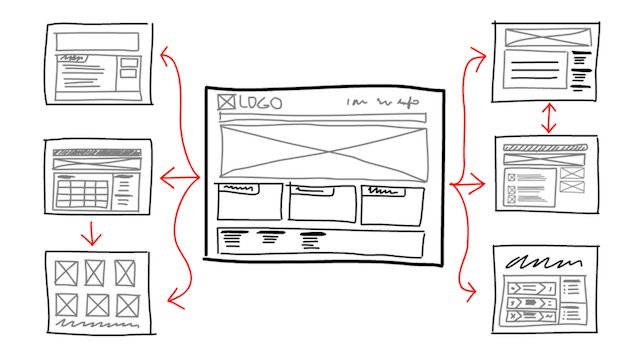This blog post was last updated on July 16, 2021.
“UX designer” is quickly becoming one of the most sought-after job titles in tech. Being a UX designer is rewarding, challenging, lucrative and interesting. You get to work with people but also quite a lot with software as you design compelling apps and website experiences.
Being a UX designer requires an impressive mix of creative, technical, and social skills. You need to be as comfortable with Adobe and Sketch as you are with interacting with a live group of users and analyzing their interactions with your mockups, prototypes, and wireframes. It’s certainly not an easy job, but if you love the work you won’t care that it’s challenging.
First and foremost…
What Exactly is a UX Designer?
You will find many different answers to this question, as there is no commonly accepted definition.
However, most UX designers would agree that, in a general sense, UX design is the art and science of designing how users experience a product from beginning to end.
UX designers use programs such as Photoshop, Sketch, and Illustrator to create storyboards, wireframes, mockups, and sitemaps, then finish their product and then test it with users.
What’s the Difference Between a UX Designer and UI Designer?
UX and UI design are close cousins and quite often combined into single roles in companies. However, while they do overlap quite a lot, they are not one and the same.
Where UX designers focus on the user experience, that is, the journey of the user through the product’s many interfaces, UI, or, user interface designers, focus on how users interact with the visual elements and cues of the product.
If we think of it in terms of car design, a UX designer would be in charge of making sure the entire experience/journey of driving the car, from looking at it to sitting down inside of it, to driving and parking it, is logical, intuitive, enjoyable, and beautiful.
While a UI designer would primarily be concerned with the way the driver interacts with the car at the level of sight and touch: making sure the dashboard icons are clear and in the most logical places, that the horn button is in the best place, that the gas cap release lever is easily identifiable but not obstructing other functions.
For this reason, many people think of UI design as a subset of UX design or as existing within the circle of UX design tasks.
What are the Traits of a Great UX Designer?
UX designers come from all walks of life, but there are certain qualities that will always make for a great candidate. Specifically, you should be:
- Passionate — UX design should feel not just like a hobby or even a career path, but a calling. You should be genuinely fascinated by patterns, the way things work, and how users interact with products.
- Empathic — To design great products you need to be able to feel the users’ pain and frustration. You need to be able to put yourself in their shoes to understand why something isn’t working for them, even though for you it may seem fine.
- Humble – No halfway decent user experience can be created in a vacuum. It requires a team and collaboration with various other roles and departments, including UI (user interface) designers, users, programmers, C-level executives, and stakeholders. It also requires absorbing a certain amount of feedback from all of the above parties and applying that feedback in the name of creating something beautiful.
- Self-Starting – You are going to need to train yourself in various areas and learn to work on your own for a while to figure things out and build your portfolio.
- Have a Genuine Interest in Technology – This almost goes without saying, but just in case…you do need to have a love of technology and, in particular, the way humans interact with technology.
If you feel you possess all of the above qualities, you are in very good shape to be successful as a UX designer.
How Do I Become a UX Designer?

Right now there are a lot of people entering or trying to enter the UX designer field from every possible angle: recent college grads with a passion for the digital world, graphic designers seeking a career change, creative people with jobs unrelated to tech seeking to get into the tech game via a creative position.
The good news is there is extremely high demand right now for UX designers.
However, if you’re trying to land a UX designer job, even an entry-level one, with little to no experience in UX design, you are going to have a tough time of it.
Even companies desperate for UX designers are willing to wait to find someone with a track record, which leaves you in a little bit of a Catch 22: You need experience as a UX designer to land your first job as a UX designer.
So how do you do it?
Here are the best steps to take to become a UX designer if you are starting from scratch.
1. Read Up
There are literally hundreds of books on UX design. However, there are certain ones that almost every experienced UX designer will tell you to read:
The Design of Everyday Things: This book by Don Norman, former director of the Institute for Cognitive Science at the University of California, is a powerful primer on how and why some products please customers while others frustrate them.
It talks about the design of not just computers and software but mundane objects such as chairs and tables, and after reading it you will have a completely different view of the design of everything around you, and your reality will be forever changed.
Smashing UX Design: This is a highly regarded and often-recommended UX reference manual and introduction to user experience for anyone just entering the field.
It provides a detailed overview of the 16 most common UX design and research tools, plus a collection of case studies from real projects that explain why specific techniques were used in specific circumstances.
Don’t Make Me Think: Don’t Make Me Think: This book by information architect and UX professional Steve Krug, was considered an “instant classic” when it came out in 2000 and is still widely considered to be one of the most important books on web usability.
There have even been other UX design books written about this book – a pretty powerful testament to its validity. Krug has since published a second edition and also an update called Don’t Make Me Think, Revisited.
There are plenty of other highly recommended books you could read on UX design, but you would be doing yourself a big favor by starting with these three.
Apart from books, there is also an almost bottomless supply of UX designer blogs, podcasts, and articles that you could dive into on your train commute or in your free time.
The more you read about it, the more prepared you’ll be for the other/subsequent steps on your journey to becoming a UX designer.
2. Find a Mentor
One of your greatest assets in becoming a UX designer will be finding a mentor – that is, someone you can always go to with questions or concerns, someone who is a source of knowledge and has worked in the field for a long time.
To find this person, you will need to become a part of the UX designer community, which means going to conferences and meetups and being outgoing (but not pushy).
Invite someone to lunch or coffee, or ask them to Skype with you for an hour, just don’t be too demanding of their time and don’t ask for additional favors such as connections or job leads (although if one of these is offered to you – by all means take it). When you’re with them, be as polite and pleasant as possible and soak up everything you can. If you’re painfully shy or just more accustomed to and comfortable with online hangouts, check out the UX community on Slack.
3. Take a Class

Since you can’t expect your mentor to actually have enough time to teach you UX design, you will need to learn by doing it.
While you will need to do it in the “real world” before trying to enter the job market (see step number 5), an important precursor to that step, that will make it much easier, is to take a course in UX design.
A good UX design course will prep you on the most important UX design concepts, tools, and resources, and allow you to practice using them.
While knowing coding typically isn’t a prerequisite for UX design courses, knowing at least some basic coding (CSS and HTML) will help you in the long term and give you an edge over the competition when it’s time to start looking for a job and also as a working UX designer. You could also benefit from a course about everyday design, as in, how and why everyday things are designed the way they are.
4. Do Some Actual Real-World UX Design Work
You’ve got the theoretical classroom experience, but, to go back to our Catch 22, you will need real work experience to actually find work.
UX hiring managers will want to see how you solve problems, how you work on a team, and how you handle deadlines and budget constraints. The only way for you to show them this is through your own case studies and experience in the field. As such, you’ll need to find a real project with real users, real team members, and real constraints.
The best way to find this project? Look for someone who has a business/website in serious need of a UX revamp but can’t afford to pay for a professional and offer them your pro-bono help.
Maybe you have a relative starting a new venture or who already owns a small but struggling company that is in dire need of a new website. Or maybe you know a local non-profit organization seeking to improve their site’s UX. Maybe the website for your local church or kid’s school hasn’t been updated since 1998.
If you look around a little, it shouldn’t be hard to find someone who could use a free UX designer, and once you did two or three of these projects you can actually start building a portfolio to show prospective employers.
A key part of this step: be sure to do usability testing to improve your design, as usability testing is a key part of the UX design process.
You can learn usability testing basics from books such as Rocket Surgery Made Easy or websites such as Usability Geek. Once you learn the basics, you can try running a few usability tests.
Be sure to take copious notes on the process so that you can improve your methodology each time around and learn from your mistakes. Smart and thorough usability testing is quite often the difference between an average UX designer and a great UX designer.
5. Land a Job
You’ve read up, found a mentor, taken a class (or two), and have added at least a few real-world projects to build your portfolio. This means you’re ready to get out there and find a job.
While there are various UX designer job boards you can use, the best UX design jobs aren’t found through LinkedIn or Craigslist but word of mouth.
Interact with as many people from as many companies as possible. Go to tech conferences and be sure to leave people a card or your contact info. At this point, it would be perfectly okay to check in with your mentor and see if he/she knows of any openings. You can also ask around through your own professional network.
Assuming your portfolio is solid, with a little luck and some legwork you should be able to line up at least a small handful of interviews and you might even be able to wrangle in more than one offer. You’ve done it – welcome to being a UX designer.
6. Never Stop Learning
In the field of UX design, you should never stop learning and never feel like you’ve “made it.” To keep excelling, you need to keep pushing yourself by learning the latest tools and staying abreast of ever-changing user preferences and expectations.
Also – don’t forget to return the favor you were given and mentor someone. You never know, the person you’re mentoring may one day be the same person who gets you your next UX design job.
Ready to Begin?
Are you ready to take your first steps towards becoming a UX designer?
The Udacity UX Designer Nanodegree Program offers students an opportunity to learn how to design impactful user experiences for products in today’s digital world. You’ll work towards building a portfolio that showcases your ability to transform user research to high-fidelity interactive designs.







